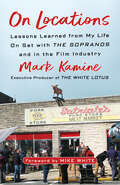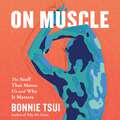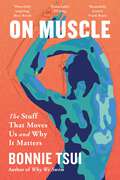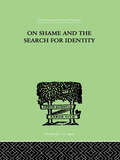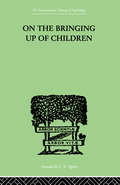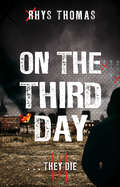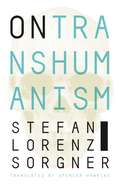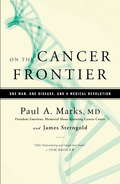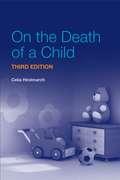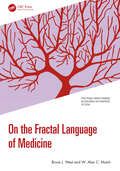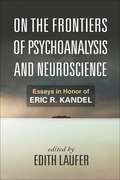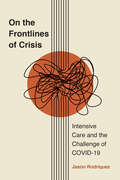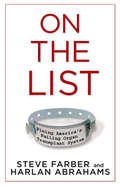- Table View
- List View
On Locations: Lessons Learned from My Life On Set with The Sopranos and in the Film Industry
by MARK KAMINECelebrating 25 years of The Sopranos: The executive producer of The White Lotus shares how he got his start in film and television production on &“the greatest TV show of all time&” (Rolling Stone)An inside look at the film industry for fans, students, and aspiring professionals — featuring a foreword by Golden Globe and Emmy Award winning creator of The White Lotus, Mike WhiteThis page-turning account of starting at the lowest rung on the production ladder among enormously famous & outrageously demanding people will be devoured for its insights, gossip, humor, & storytelling. Married and with a child, the author takes unpaid gigs to get a foot in the door, and eventually ends up working on all seasons of The Sopranos, often named the best TV show ever.The show's setting and its creator's insistence on accuracy placed the native New Jersey author in the right place at the right time to become part of television history, and to witness the effects of sudden fame and acclaim on the show's principal players.Includes many stories about guest stars like Steve Buscemi, Peter Bogdanovich, and Lauren Bacall, as well as the beloved cast, including new tales of James Gandolfini, who Kamine first meets after David Chase casts him as the Dean of Admissions in the classic first season "College" episode. Later, after he&’s been promoted, Kamine gets the calls from Gandolfini when he's hungover, or still drunk, and might or might not make it to the shoot that day. One night, Kamine tries to prevent Gandolfini from taking a swim in the ocean after they've been drinking all night, telling him it could be dangerous but Jim doesn't listen.Woven in is a personal story of home life and strife, achievement and frustration, anxiety and accomplishment. The book's epilogue brings readers up to the moment as the author, after many more years as an anonymous everyman, eventually enjoys outsize professional success as executive producer of the HBO hit series created by Mike White, The White Lotus.
On Moral Medicine: Theological Perspectives on Medical Ethics
by Allen Verhey M. Therese Lysaught Joseph Kotva Stephen E. LammersIn print for more than two decades, On Moral Medicine remains the definitive anthology for Christian theological reflection on medical ethics. This third edition updates and expands the earlier awardwinning volumes, providing classrooms and individuals alike with one of the finest available resources for ethics-engaged modern medicine.
On Muscle: The Stuff That Moves Us and Why It Matters
by Bonnie Tsui'Remarkable . . . A singular book about the true meanings of strength and flexibility, about our ability to define who we are and who we might be' Ed Yong, New York Times bestselling author of An Immense World and I Contain MultitudesFrom the bestselling author of Why We Swim comes a mind-expanding exploration of muscle that will change the way you think about how we move and why it matters.Cardiac, smooth, skeletal-these three different types of muscle in our bodies make our hearts beat; push food through our intestines, blood through our vessels, attach to our bones and help us move. Individually, they do different things. Collectively, they drive us through our days.Join athlete and writer Bonnie Tsui as she jumps headfirst into the intriguing world of muscle from the five angles of strength, form, action, flexibility and endurance. Tsui introduces us to the first female weightlifter to pick up the famed Scottish Dinnie Stones, then takes us on a 50-mile run through the Nevada desert that follows the path of escape from a Native boarding school, giving the concept of endurance new meaning. She travels to Oslo, where cutting-edge research reveals how muscles help us bounce back after injury and illness, an important aspect of longevity. She jumps into the action with a historic Double Dutch club in Washington, D.C., to explain anew what Charles Darwin meant by the brain-body connection.On Muscle is a powerful reminder that using our muscles promote longevity, joy, and, most important, the feeling that we can do anything.
On Muscle: The Stuff That Moves Us and Why It Matters
by Bonnie Tsui'Remarkable . . . A singular book about the true meanings of strength and flexibility, about our ability to define who we are and who we might be' Ed Yong, New York Times bestselling author of An Immense World and I Contain MultitudesFrom the bestselling author of Why We Swim comes a mind-expanding exploration of muscle that will change the way you think about how we move and why it matters.Cardiac, smooth, skeletal-these three different types of muscle in our bodies make our hearts beat; push food through our intestines, blood through our vessels, attach to our bones and help us move. Individually, they do different things. Collectively, they drive us through our days.Join athlete and writer Bonnie Tsui as she jumps headfirst into the intriguing world of muscle from the five angles of strength, form, action, flexibility and endurance. Tsui introduces us to the first female weightlifter to pick up the famed Scottish Dinnie Stones, then takes us on a 50-mile run through the Nevada desert that follows the path of escape from a Native boarding school, giving the concept of endurance new meaning. She travels to Oslo, where cutting-edge research reveals how muscles help us bounce back after injury and illness, an important aspect of longevity. She jumps into the action with a historic Double Dutch club in Washington, D.C., to explain anew what Charles Darwin meant by the brain-body connection.On Muscle is a powerful reminder that using our muscles promote longevity, joy, and, most important, the feeling that we can do anything.
On My Way Back to You: One Couple's Journey through Catastrophic Illness to Healing and Hope
by Sarah CartSarah Cart&’s On My Way Back to You is a first-hand account of the rollercoaster world of lifesaving transplants and the unimaginable challenges Sarah faced as she struggled to manage her husband&’s devastating illness and to save his life, their marriage, and her own sanity. Throughout her 42-year marriage, writer Sarah Cart has enjoyed a life of &“gloriously controlled chaos,&” as she and her husband Ben, a successful entrepreneur and seasoned outdoorsman, embarked on numerous adventures with their four active sons. Then the unthinkable happened. In suspenseful and heartrending detail, Cart shares how Ben developed an incurable autoimmune condition that was manageable and under control one minute and threatened to kill him the next, landing him in the ICU as the Covid pandemic closed the world down. Thrust into the role of nurse and caregiver, Sarah joined the ranks of 39 million Americans who champion and care for an ailing loved one. In addition to confronting doubts, fears, and endless setbacks, aggravations, and red tape, she also had to consent to daunting procedures on Ben&’s behalf. Too, there were the months-long Covid-era restrictions on hospital visitations and the post-surgery snafus with home healthcare personnel. Thank goodness for the heartfelt communiques with family and friends, all of which reflect the faith, fortitude, grit, and grace that sustained her. While readers will identify with Sarah&’s anxieties and be moved by hers and Ben&’s strength, they will also learn the questions to ask, the notes to take, the signs to never overlook, and the self-care necessary should they ever find themselves in her shoes. On My Way Back to You is a profoundly inspirational account of one couple&’s medical odyssey and the patience, determination, and love that ultimately helped them find their way back to one another.
On Rotation
by Shirlene ObuobiGhanaian-American Angela Appiah has checked off all the boxes for the 'Perfect Immigrant Daughter': enroll in an elite medical school; snag a suitable lawyer/doctor/engineer boyfriend, and surround herself with a gaggle of successful and/or loyal friends... But when her boyfriend dumps her, her best friend pulls away, and she bombs the most important exam of her medical career, Angie finds herself in the middle of a quarter life crisis of epic proportions. To make matters worse, her parents are suddenly a lot less proud of their daughter, now that she's not following through with the path they chose for her.Just when things couldn't get any more complicated, enter Ricky Gutierrez - brilliant, thoughtful, sexy, and most importantly, seems to see Angie for who she is instead of what she can represent. Unfortunately, he's also got 'wasteman' practically tattooed across his forehead, and Angie's done chasing mirages of men. Or so she thinks... For someone who's always been in control, Angie realizes that there's one thing she can't plan on: matters of her heart.For fans of Grey's Anatomy and Seven Days in June, this dazzling debut novel by Shirlene Obuobi explores that time in your life when you must decide what you want, how to get it, and who you are, all while navigating love, friendship, and the realization that the path you're traveling is going to be a bumpy ride.* ONE OF TEEN VOGUE'S '25 BOOKS BY BLACK AUTHORS THEY CAN'T WAIT TO READ THIS YEAR' ** ONE OF BETCHES' '22 BOOKS YOU NEED TO READ THIS YEAR'*(P) 2022 HarperCollins Publishers
On Rotation: The perfect will-they-won't-they romance for fans of GREY'S ANATOMY and THE LOVE HYPOTHESIS
by Shirlene Obuobi'As a fan of Grey's Anatomy (and Chicago Med!), I couldn't put down On Rotation, and you won't be able to, either... I personally couldn't get enough' MEG CABOT 'A smart, fun rom-com. What I loved most about the book was the fact that the love interest was just as delightfully flawed and three-dimensional as the heroine, and that made me root for their happy ending all the more' BETH O'LEARY Ghanaian-American Angela Appiah has checked off all the boxes for the 'Perfect Immigrant Daughter': enroll in an elite medical school; snag a suitable lawyer/doctor/engineer boyfriend, and surround herself with a gaggle of successful and/or loyal friends... But when her boyfriend dumps her, her best friend pulls away, and she bombs the most important exam of her medical career, Angie finds herself in the middle of a quarter life crisis of epic proportions. To make matters worse, her parents are suddenly a lot less proud of their daughter, now that she's not following through with the path they chose for her. Just when things couldn't get any more complicated, enter Ricky Gutierrez - brilliant, thoughtful, sexy, and most importantly, seems to see Angie for who she is instead of what she can represent. Unfortunately, he's also got 'wasteman' practically tattooed across his forehead, and Angie's done chasing mirages of men. Or so she thinks... For someone who's always been in control, Angie realizes that there's one thing she can't plan on: matters of her heart.For fans of Grey's Anatomy and Seven Days in June, this dazzling debut novel by Shirlene Obuobi explores that time in your life when you must decide what you want, how to get it, and who you are, all while navigating love, friendship, and the realization that the path you're traveling is going to be a bumpy ride. 'Narrated by a strong lead with an unforgettable voice, On Rotation is an original romance novel bursting with charm, humor and the most loveable characters. I'm besotted with Angie and her posse!' LIZZIE DAMILOLA BLACKBURN, author of Yinka, Where is Your Huzband?
On Second Thought: How Ambivalence Shapes Your Life
by William R. MillerThe rich inner world of a human being is far more complex than either/or. You can love and hate, want to go and want to stay, feel both joy and sadness. Psychologist William Miller--one of the world's leading experts on the science of change--offers a fresh perspective on ambivalence and its transformative potential in this revealing book. Rather than trying to overcome indecision by force of will, Dr. Miller explores what happens when people allow opposing arguments from their &“inner committee members&” to converse freely with each other. Learning to tolerate and even welcome feelings of ambivalence can help you get unstuck from unwanted habits, clarify your desires and values, explore the pros and cons of tough decisions, and open doorways to change. Vivid examples from everyday life, literature, and history illustrate why we are so often "of two minds," and how to work through it.
On Shame And The Search For Identity
by Lynd, Helen MerrellFirst published in 1999. Routledge is an imprint of Taylor & Francis, an informa company.
On Speed: From Benzedrine to Adderall
by Nicolas RasmussenAn extensively researched account of the ups and downs in the history of uppers Uppers. Crank. Bennies. Dexies. Greenies. Black Beauties. Purple Hearts. Crystal. Ice. And, of course, Speed. Whatever their street names at the moment, amphetamines have been an insistent force in American life since they were marketed as the original antidepressants in the 1930s. On Speed tells the remarkable story of their rise, their fall, and their surprising resurgence. Along the way, it discusses the influence of pharmaceutical marketing on medicine, the evolving scientific understanding of how the human brain works, the role of drugs in maintaining the social order, and the centrality of pills in American life. Above all, however, this is a highly readable biography of a very popular drug. And it is a riveting story. Incorporating extensive new research, On Speed describes the ups and downs (fittingly, there are mostly ups) in the history of amphetamines, and their remarkable pervasiveness. For example, at the same time that amphetamines were becoming part of the diet of many GIs in World War II, an amphetamine-abusing counterculture began to flourish among civilians. In the 1950s, psychiatrists and family doctors alike prescribed amphetamines for a wide variety of ailments, from mental disorders to obesity to emotional distress. By the late 1960s, speed had become a fixture in everyday life: up to ten percent of Americans were thought to be using amphetamines at least occasionally.Although their use was regulated in the 1970s, it didn't take long for amphetamines to make a major comeback, with the discovery of Attention Deficit Disorder and the role that one drug in the amphetamine family—Ritalin—could play in treating it. Today’s most popular diet-assistance drugs differ little from the diet pills of years gone by, still speed at their core. And some of our most popular recreational drugs—including the "mellow" drug, Ecstasy—are also amphetamines. Whether we want to admit it or not, writes Rasmussen, we’re still a nation on speed.
On The Bringing Up Of Children (International Library Of Psychology Ser.)
by Rickman, JohnFirst Published in 1999. Routledge is an imprint of Taylor & Francis, an informa company.
On The Third Day
by Rhys ThomasSociety is on the brink of collapse. The Old World is vanishing, the New World is taking over. There are no rules. Not now that a deadly disease is spreading that causes its victims to turn violent. Previously loving people become murderous. No-one can tell who will turn and who will not. A work of force and dark brilliance - the perfect expression of the terrors of the 21st Century
On Transhumanism
by Stefan Lorenz SorgnerTranshumanism is widely misunderstood, in part because the media have exaggerated current technologies and branded the movement as dangerous, leading many to believe that hybrid humans may soon walk among us and that immortality, achieved by means of mind-uploading, is imminent. In this essential and clarifying volume, Stefan Lorenz Sorgner debunks widespread myths about transhumanism and tackles the most pressing ethical issues in the debate over technologically assisted human enhancement.On Transhumanism is a vital primer on the subject, written by a world-renowned expert. In this book, Sorgner presents an overview of the movement’s history, capably summarizing the twelve pillars of transhumanist discourse and explaining the great diversity of transhumanist responses to each individual topic. He highlights the urgent ethical challenges related to the latest technological developments, inventions, and innovations and compares the unique cultural standing of transhumanism to other cultural movements, placing it within the broader context of the Enlightenment, modernity, postmodernity, and the philosophical writings of Nietzsche. Engagingly written and translated and featuring an introduction for North American readers, this comprehensive overview of the cultural and philosophical movement of transhumanism will be required reading for students of posthumanist philosophy and for general audiences interested in learning about the transhumanist movement.
On Transhumanism
by Stefan Lorenz SorgnerTranshumanism is widely misunderstood, in part because the media have exaggerated current technologies and branded the movement as dangerous, leading many to believe that hybrid humans may soon walk among us and that immortality, achieved by means of mind-uploading, is imminent. In this essential and clarifying volume, Stefan Lorenz Sorgner debunks widespread myths about transhumanism and tackles the most pressing ethical issues in the debate over technologically assisted human enhancement.On Transhumanism is a vital primer on the subject, written by a world-renowned expert. In this book, Sorgner presents an overview of the movement’s history, capably summarizing the twelve pillars of transhumanist discourse and explaining the great diversity of transhumanist responses to each individual topic. He highlights the urgent ethical challenges related to the latest technological developments, inventions, and innovations and compares the unique cultural standing of transhumanism to other cultural movements, placing it within the broader context of the Enlightenment, modernity, postmodernity, and the philosophical writings of Nietzsche. Engagingly written and translated and featuring an introduction for North American readers, this comprehensive overview of the cultural and philosophical movement of transhumanism will be required reading for students of posthumanist philosophy and for general audiences interested in learning about the transhumanist movement.
On Vanishing: Mortality, Dementia, and What It Means to Disappear
by Lynn Casteel HarperAn essential book for those coping with Alzheimer's and other cognitive disorders that “reframe[s] our understanding of dementia with sensitivity and accuracy . . . to grant better futures to our loved ones and ourselves” (Parul Sehgal, The New York Times).An estimated fifty million people in the world suffer from dementia. Diseases such as Alzheimer's erase parts of one's memory but are also often said to erase the self. People don't simply die from such diseases; they are imagined, in the clichés of our era, as vanishing in plain sight, fading away, or enduring a long goodbye. In On Vanishing, Lynn Casteel Harper, a Baptist minister and nursing home chaplain, investigates the myths and metaphors surrounding dementia and aging, addressing not only the indignities caused by the condition but also by the rhetoric surrounding it. Harper asks essential questions about the nature of our outsized fear of dementia, the stigma this fear may create, and what it might mean for us all to try to “vanish well.”Weaving together personal stories with theology, history, philosophy, literature, and science, Harper confronts our elemental fears of disappearance and death, drawing on her own experiences with people with dementia both in the American healthcare system and within her own family. In the course of unpacking her own stories and encounters—of leading a prayer group on a dementia unit; of meeting individuals dismissed as “already gone” and finding them still possessed of complex, vital inner lives; of witnessing her grandfather’s final years with Alzheimer’s and discovering her own heightened genetic risk of succumbing to the disease—Harper engages in an exploration of dementia that is unlike anything written before on the subject.A rich and startling work of nonfiction, On Vanishing reveals cognitive change as it truly is, an essential aspect of what it means to be mortal.
On the Cancer Frontier: One Man, One Disease, and a Medical Revolution
by James Sterngold Paul A. MarksIn 1950, a diagnosis of cancer was all but a death sentence. Mortality rates only got worse, and as late as 1986, an article in the New England Journal of Medicine lamented: "We are losing the war against cancer. ” Cancer is one of humankind’s oldest and most persistent enemies; it has been called the existential disease. But we are now entering a new, and more positive, phase in this long campaign. While cancer has not been cured-and a cure may elude us for a long time yet-there has been a revolution in our understanding of its nature. Years of brilliant science have revealed how this individualistic disease seizes control of the foundations of life-our genes-and produces guerrilla cells that can attack and elude treatments. Armed with those insights, scientists have been developing more effective weapons and producing better outcomes for patients. Paul A. Marks, MD, has been a leader in these efforts to finally control this devastating disease. Marks helped establish the strategy for the "war on cancer” in 1971 as a researcher and member of President Nixon’s cancer panel. As the president and chief executive officer for nineteen years at the world’s pre-eminent cancer hospital, the Memorial Sloan-Kettering Cancer Center, he was instrumental in ending the years of futility. He also developed better therapies that promise a new era of cancer containment. Some cancers, like childhood leukemia and non-Hodgkin’s lymphoma, that were once deadly conditions, are now survivable-even curable. New steps in prevention and early diagnosis are giving patients even more hope. On the Cancer Frontier is Marks’ account of the transformation in our understanding of cancer and why there is growing optimism in our ability to stop it.
On the Death of a Child
by Christine HindmarchThe death of a child - whether during or following birth, through illness, through accident, or through suicide - is one of the greatest challenges families, carers, friends, and the health and social care professionals who support them can face. This book provides professionals with practical advice, resources for further support and reading, and much-needed reassurance that whatever contact they have with the bereaved, and however inadequate they may feel to the task, they can make a difference. With revised material and an entirely new chapter reflecting recent developments in bereavement theory, the third edition of this classic text offers unique insights for professionals with varying levels of experience. From theory and narrative come practical ideas on what to say, what to do, how to behave, how to stay humble in situations where the only real experts are the bereaved themselves, and how professionals can look after themselves in what can be particularly traumatic and upsetting circumstances.
On the Fence: The Hidden World of the Hard of Hearing
by Mark DrolsbaughAlthough Drolsbaugh is listed as author, he is actually the editor of writings by 37 individuals. They label themselves hard of hearing or hearing impaired. This is a very different population than the culturally deaf, signing community. Authors found their community in Self Help for the Hard of Hearing (SHHH), later renamed as HLAA (Hearing Loss Association of America). A bio of the authors is included at the end. They vary from childhood age to the elderly.
On the Fractal Language of Medicine (Fractional Order Thinking in Exploring the Frontiers of STEM)
by Bruce J. West W. Alan MutchOn the Fractal Language of Medicine bridges a very clear gap among the knowledge gained over the last 20 years in the physical and life sciences on network theory, organ synchronicity and communication, the understanding of fractal signatures in health and disease and the importance of fractional calculus in integrating these concepts.The authors opine that the field of medicine has not appreciated this hard-won knowledge and has suffered greatly as a result. This book addresses this perceived deficiency by introducing medical researchers, clinicians, residents, first-year medical students and members of allied fields to the work of the so-called hard sciences. It seeks to facilitate effective communication between empiricists and theorists by making interdisciplinary efforts to explain complex mathematical concepts to physicians and, equally important, to elucidate complex medical concepts to physicists or mathematicians.This book will be of great interest to medical students, professionals and academics, as well as students and researchers of applied mathematics, especially those interested in fractional calculus and fractals.
On the Frontiers of Psychoanalysis and Neuroscience: Essays in Honor of Eric R. Kandel
by Joseph Ledoux Mark Solms Edith LauferBuilding crucial bridges between psychoanalysis and the neurosciences, this compelling volume brings together prominent authorities from multiple disciplines. The volume highlights the contributions of Eric R. Kandel, whose seminal articles helped launch the fledgling field of neuropsychoanalysis. Contributors address what contemporary neuroscientific research reveals about how psychoanalytic techniques work and why they are effective. Also examined are ways in which psychoanalysis can contribute to scientific explorations of the mind. Each chapter is followed by a thoughtful response. This material was originally published as a special issue of The Psychoanalytic Review (Vol. 99, No. 4, 2012), editor, Alan J. Barnett, PhD.
On the Frontlines of Crisis: Intensive Care and the Challenge of COVID-19 (Critical Issues in Health and Medicine)
by Jason RodriquezOn the Frontlines of Crisis is a powerful account of the experiences of healthcare workers during the COVID-19 pandemic. As hospitals worldwide became overwhelmed by an influx of critically ill patients, those working in intensive care units (ICUs) were thrust into an unprecedented battle against a deadly virus about which little was understood. Rodriquez takes readers into the heart of two Massachusetts ICUs to learn about the people who put their lives on the line and faced severe challenges as they treated critically ill patients at the peak of the pandemic. A dramatic spike in mental health distress among these healthcare workers was a consequence of the pandemic, but was also a result of the changing dynamics within the healthcare system itself. Here, Rodriquez examines the impact of the development of the contemporary focus on “clinical empathy.” This clinical method, while intended to improve patient care, had profound implications for healthcare workers during the pandemic, often blurring the lines between professional distance and personal involvement, increasing the emotional demands on staff and heightened their vulnerability to anxiety, depression, post-traumatic stress, and burnout. Through the personal stories of those who were in the ICU, On the Frontlines of Crisis offers a sobering reflection on the social and emotional costs of caring for patients.
On the List: Fixing America's Failing Organ Transplant System
by Steve Farber Harlan AbrahamsTwo families came together in the waiting room of a Denver hospital on May 11, 2004, to await kidney transplants for loved ones. In the first operation, Gregg Farber, 32, a real estate executive, donated a kidney to his father, Steve, a 60-year-old Denver lawyer and power broker. In the second, Guatemalan refugee and landscaper Ernesto Delaroca, also 32, donated a kidney to his sister Sandra, 19, a restaurant worker. The stories of how the Farber and Delaroca families made their separate journeys to the operating room offers insight into the hazards and inequities of a cobbled-together system that each year leaves more than 98,000 gravely ill Americans on the waiting list for a life-saving transplant. Steve Farber's experience inspired him to write On the List with Harlan Abrahams. They examine the ethical, legal, political, and economic debates over organ transplant policies, expose the gray market for transplants in Third World countries, and propose solutions to one of the world's most pressing health issues. An informative and inspiring guide to those who face transplant operations, the book is also a call to reform a system that is truly, and fatally, flawed.
On the Move
by Oliver SacksAn impassioned, tender, and joyous memoir by the author of Musicophilia and The Man Who Mistook His Wife for a Hat. When Oliver Sacks was twelve years old, a perceptive schoolmaster wrote in his report: "Sacks will go far, if he does not go too far." It is now abundantly clear that Sacks has never stopped going. From its opening pages on his youthful obsession with motorcycles and speed, On the Move is infused with his restless energy. As he recounts his experiences as a young neurologist in the early 1960s, first in California, where he struggled with drug addiction and then in New York, where he discovered a long-forgotten illness in the back wards of a chronic hospital, we see how his engagement with patients comes to define his life. With unbridled honesty and humor, Sacks shows us that the same energy that drives his physical passions--weight lifting and swimming--also drives his cerebral passions. He writes about his love affairs, both romantic and intellectual; his guilt over leaving his family to come to America; his bond with his schizophrenic brother; and the writers and scientists--Thom Gunn, A. R. Luria, W. H. Auden, Gerald M. Edelman, Francis Crick--who influenced him. On the Move is the story of a brilliantly unconventional physician and writer--and of the man who has illuminated the many ways that the brain makes us human.
On the Move: A Life
by Oliver SacksWhen Oliver Sacks was twelve years old, a perceptive schoolmaster wrote in his report: “Sacks will go far, if he does not go too far.” It is now abundantly clear that Sacks has never stopped going. From its opening pages on his youthful obsession with motorcycles and speed, On the Move is infused with his restless energy. As he recounts his experiences as a young neurologist in the early 1960s, first in California, where he struggled with drug addiction, and then in New York, where he discovered a long-forgotten illness in the back wards of a chronic hospital, we see how his engagement with patients comes to define his life.<P><P> With unbridled honesty and humor, Sacks shows us that the same energy that drives his physical passions—weight lifting and swimming—also drives his cerebral passions. He writes about his love affairs, both romantic and intellectual; his guilt over leaving his family to come to America; his bond with his schizophrenic brother; and the writers and scientists—Thom Gunn, A. R. Luria, W. H. Auden, Gerald M. Edelman, Francis Crick—who influenced him. On the Move is the story of a brilliantly unconventional physician and writer—and of the man who has illuminated the many ways that the brain makes us human.
On the Move: A Life
by Oliver SacksNATIONAL BESTSELLER • A &“wonderful memoir&” (Los Angeles Times) about a brilliantly unconventional physician and writer, a man who has illuminated the many ways that the brain makes us human. • &“Intimate.... Brim[s] with life and affection.&” —The New York TimesWhen Oliver Sacks was twelve years old, a perceptive schoolmaster wrote: &“Sacks will go far, if he does not go too far.&” It is now abundantly clear that Sacks has never stopped going. With unbridled honesty and humor, Sacks writes about the passions that have driven his life—from motorcycles and weight lifting to neurology and poetry. He writes about his love affairs, both romantic and intellectual; his guilt over leaving his family to come to America; his bond with his schizophrenic brother; and the writers and scientists—W. H. Auden, Gerald M. Edelman, Francis Crick—who have influenced his work.
